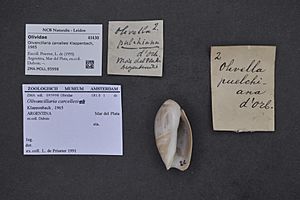Olivancillaria carcellesi facts for kids
Quick facts for kids Olivancillaria carcellesi |
|
|---|---|
 |
|
| Scientific classification | |
| Synonyms | |
|
Olivancillaria buckuporum Thomé, 1966 |
Olivancillaria carcellesi is a type of sea snail. It is a marine gastropod mollusk that belongs to the family Olividae, which are often called "olive snails" because of their smooth, oval shells. This fascinating creature lives in the ocean and is known for its unique shell.
Contents
What is Olivancillaria carcellesi?
Olivancillaria carcellesi is a specific kind of sea snail. Sea snails are mollusks, which means they are soft-bodied animals. They are also gastropods, a large group of mollusks that includes snails and slugs. Many gastropods, like Olivancillaria carcellesi, have a single shell that they carry on their back.
The Olive Snail Family
This snail belongs to the Olividae family. Snails in this family are called "olive snails." They are known for their beautiful, shiny, and often colorful shells. These shells are usually smooth and shaped a bit like an olive, which is how they got their name.
Shell Description
The shell of Olivancillaria carcellesi can be anywhere from 25 millimeters (about 1 inch) to 55 millimeters (about 2.2 inches) long. This makes it a medium-sized sea snail. The shell acts like a protective home for the soft body of the snail inside.
Shell Features
Like other olive snails, the shell of Olivancillaria carcellesi is typically very smooth and glossy. This smooth surface helps the snail move easily through sand or mud on the seafloor. The exact colors and patterns can vary, but they often have shades of brown, gray, or cream.
Where Does It Live? (Distribution)
Olivancillaria carcellesi lives in the Atlantic Ocean. Its natural home stretches along the coast of South America, from Brazil in the north all the way down to Argentina in the south.
Ocean Habitat
These snails are marine animals, meaning they live in saltwater. They are usually found on sandy or muddy seabeds in shallow to moderate depths. They spend their time burrowing in the sand, looking for food.
See also
 In Spanish: Olivancillaria carcellesi para niños
In Spanish: Olivancillaria carcellesi para niños

